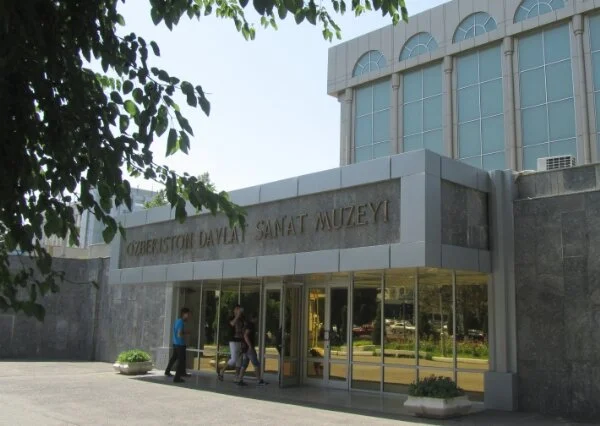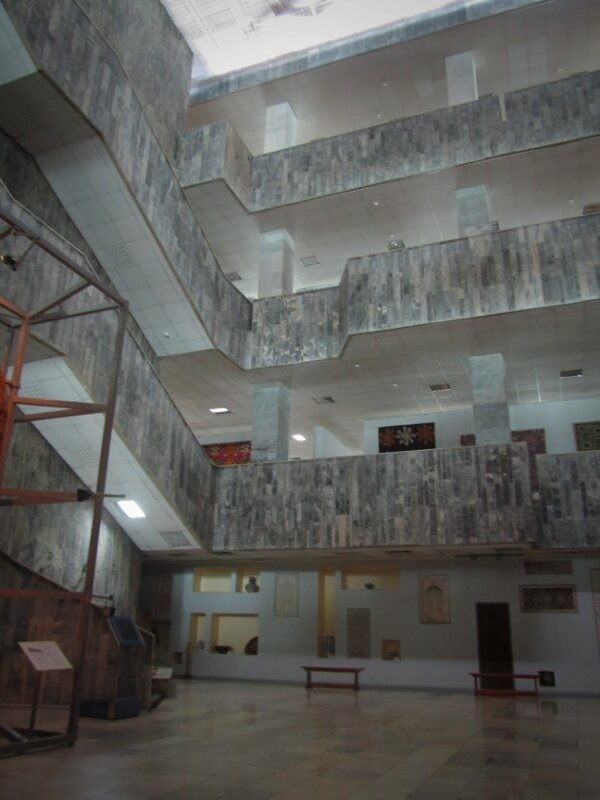DAY 16 - TASHKENT AGAIN
SYNOPSIS: A VISIT AT THE MUSEUM OF FINE ARTS AND A VISIT AT THE INTERNATIONAL UNIVERSITY OF TASHKENT. ABOUT MY EXPERIENCES AS A TOURIST AND ABOUT WHAT MORE LIKELY GOES ON IN REALITY.
I can’t even help it anymore, but I wake up at 5:45, the time the sun brightens the sky enough for my internal antenna to pick up that the night is over. There really was no reason to get up this early, but what can I do?
I had a few loose ends to take care of today: First, visit a museum. Second, ride the Tashkent Subway. Third, visit an English professor at the University of Tashkent. Fourth, find good enough Uzbek currency to take home as souvenir (you have no idea in what condition some of the bills are which are in circulation here). I succeeded.
There is a list of ten or more museums to choose from, and as an art historian, I settled for the most natural choice, the Fine Arts Museum. I have complained so many times about the limited scope of museums in the Arab world (from Lebanon to Syria, from Egypt to Iraq) and even in Iran. As I sweated my way downwards the four floors of the museum, I am happy to report that there was a section of Japanese and Chinese art and artifacts, there was room after room of European second-rate European art spanning the 15th to the 19th Century, including even a Rembrandt (maybe). There were a few pieces of Russian avant-garde art, including two by Kandinsky. There were the Russian classics, such as Repin and Volkov and there was a substantial section dedicated to Uzbek local artists, including folk art and crafts. There were furniture, sculpture, painting, and crafts; there were architectural elements and ceramics. It was an impressive spread. The condition of many pieces was not great. In fact, that Rembrandt (if it was not a painting of the school of Rembrandt) had been so badly patched up that it was visible to the naked eye.
I have to add though that the State of Uzbekistan cannot exactly be credited for amassing this collection. As I read, it was confiscated from a cousin of the tsar, a Grand Duke Romanov. But I credit the government for preserving and caring for it and for providing it as a teaching tool. Case in point, as everywhere else, a class of school children was guided through the museum as I was there. The building itself looked like nothing much from the outside, but was interesting inside. Stone balconies with little “slits” here and there opened up to a central court, mirroring in a sense the local architecture. I very much enjoyed this visit.
Tashkent is proud of its Metro, started in the 1970’s and expanded by now into a network of lines connecting the far-flung suburbs with the center and each other quickly and efficiently. Just like I had seen decades earlier in Moscow, great pride is taken in decorating the individual stations. My guidebook said there was no photography allowed and that I might have to show my passport to enter the metro! I was not checked and nowhere did I see a no-photo sign. But each entrance and each platform I stopped at had a police officer patrolling; what man-power! But I managed to snap a few pictures hiding from the officer’s view for a few seconds.
And finally, I like to bring back currency from each country. It is so telling to figure out what is on a country's money. You can tell a lot about values and history that way. One dollar translates into about 2000-2800 Som, depending on where you exchange it. But the largest bill I have seen in circulation is 1000 sum, less than 50 cents. Imagine paying a hotel bill of $120 as I just did in the local currency! People here literally carry stacks of money. And they have a very distinguished and uniform way of counting. Most of the bills less than 1000 sum are worn and torn. It was no small matter to find some relatively decent bills, not knowing the language. Everyone thought I was trying to exchange dollars and nobody could grasp the idea that I wanted to exchange ugly into pretty bills. But I finally managed.
INTERNATIONAL UNIVERSITY TASHKENT
Through a friend, I had been put in touch with an English professor from the International University of Tashkent. I had hoped that I would be able to get a bit of a tour of the institution as I am always curious about other places of higher education. But already from the email exchange I could tell that this man was awfully busy. I was able in rapid succession to ask him a series of questions but after half an hour it was clear that he had to move on to other more pressing appointments. I was grateful for at least this bit of time as he confirmed one thing I had suspected all along: Daily life of Uzbeks is a lot more complicated than it appears on the surface to me as a tourist.
From my perspective, Uzbekistan is a clean, well-run, tourist-friendly, service-oriented, safe, and interesting country full of wonderful things to experience. And that is how you would find it if you came here. But beneath the surface, there is a still corrupt bureaucracy, there are high prices and low salaries, there is lack of work, there is a police state conflicting with tribal values, there is a rise in religiosity and religious extremism in a country proud of its secularity, there are incidents of human-rights violations and there is a general exodus of the population into other parts of the world, including Israel, the United States and Asia. All this is invisible to me. I travel in an elite status and many of the people I interact with in the small, privately-owned hotels where I stayed are already part of a new entrepreneur upper middle class. This certainly does not come as a surprise; a tourist is just a tourist after all. It is still good to remind myself that as much as I learned traveling in this part of the world, there is much, much more that I missed.
This was my first encounter with a Central Asian country. Common denominator between the Arab world, Turks, Persians, and Central Asians is Islam. But culturally and ethnically, the differences between these people are vast and run deep.
I am always moved when I am allowed to experience another of the colorful facets of humanity this world has produced and I am grateful that so far I continue to have the means, the health, and the opportunity to do so. And as every night, I thank my pantheon for keeping me safe.
Good night.







